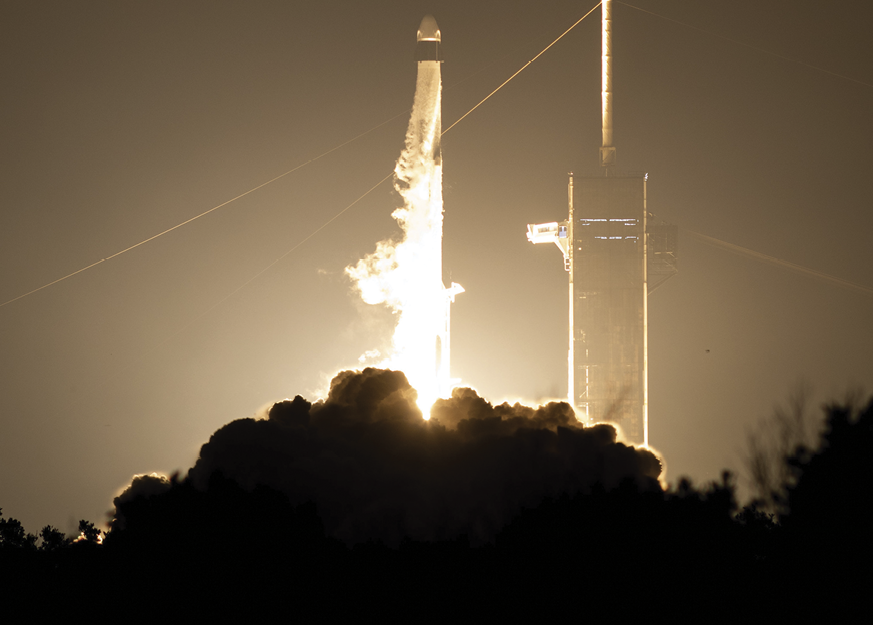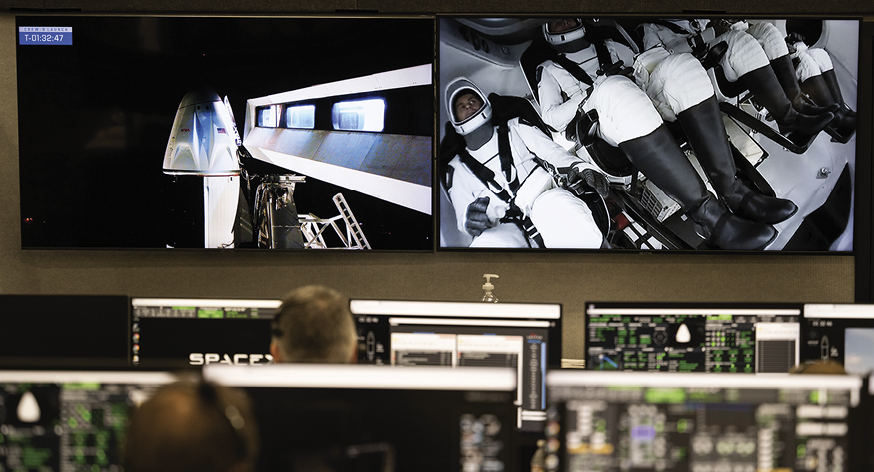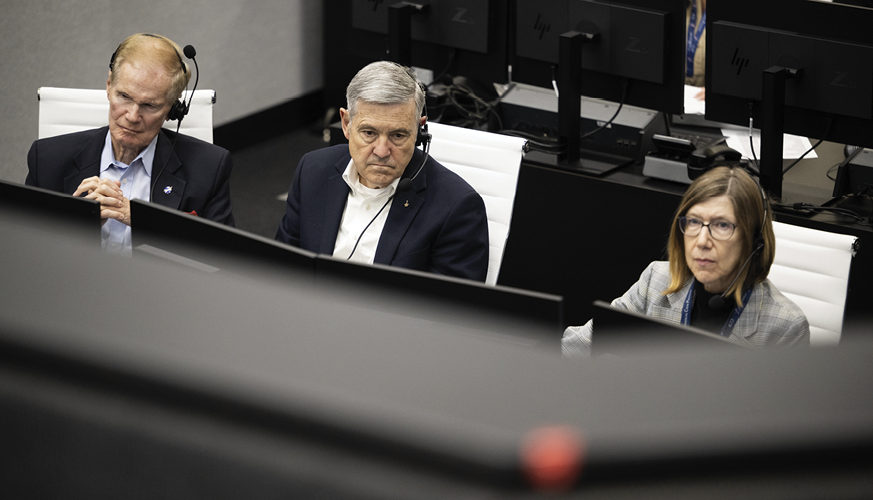- Home
- Media Kit
- MediaJet
- Current Issue
- Past Issues
- Ad Specs-Submission
- Ad Print Settings
- Reprints (PDF)
- Photo Specifications (PDF)
- Contact Us
![]()
ONLINE
![]()
ONLINE

A New Era of
Space Exploration
Editors’ Note
Senator Bill Nelson was sworn in as the 14th NASA Administrator on May 3, 2021, tasked with carrying out the Biden-Harris administration’s vision for the agency. Nelson chaired the Space and Science Subcommittee in the U.S. House of Representatives for six years and the U.S. Senate for 12 years. He then served as the Ranking Member of the full Senate Commerce, Science, and Transportation Committee. Nelson was recognized as the leading space program advocate in Congress. In 2010, Nelson and Senator Kay Bailey Hutchinson (R-Texas) passed the landmark NASA legislation that mapped out a new future for NASA and set the agency on its present dual course of both government and commercial missions. In 2017, Nelson and Senator Ted Cruz (R-Texas) authored the NASA Transition Authorization Act of 2017, which expanded NASA’s commercial activities in space. During his time in Congress, Nelson was a strong advocate for NASA’s Earth science programs and authored numerous pieces of legislation to combat and mitigate the effects of climate change. Nelson was also a vocal proponent for STEM career training and education programs to create and fill the jobs of the future. In 1986, he flew on the 24th flight of the Space Shuttle. The mission on Columbia orbited the earth 98 times over six days. Nelson conducted 12 medical experiments including the first American stress test in space and a cancer research experiment sponsored by university researchers. Nelson has served in public office over four decades, first in the state legislature and U.S. Congress, then as State Treasurer. He was elected three times to the United States Senate, representing Florida for 18 years. His committees included the breadth of government policy from defense, intelligence, and foreign policy to finance, commerce, and healthcare. From president of 4-H to international president of the Key Club in high school, Nelson has always known the importance of investing in your neighbors and community to create a better future. Nelson continued to serve his community and country while in college at the University of Florida, Yale, and University of Virginia Law School through various service organizations and school leadership positions. He served on active duty as a Captain in the U.S. Army.
Agency Brief
The National Aeronautics and Space Administration (NASA) is America’s civil space program and the global leader in space exploration. The agency has a diverse workforce of just under 18,000 civil servants, and works with many more U.S. contractors, academia, and international and commercial partners to explore, discover, and expand knowledge for the benefit of humanity. With an annual budget of $23.2 billion in Fiscal Year 2021, which is less than 0.5 percent of the overall U.S. federal budget, NASA supports more than 312,000 jobs across the United States, generating more than $64.3 billion in total economic output (Fiscal Year 2019). At its 20 centers and facilities across the country – and the only National Laboratory in space – NASA (nasa.gov) studies Earth, including its climate, the Sun, and the solar system and beyond. It conducts research, testing, and development to advance aeronautics, including electric propulsion and supersonic flight. NASA develops and funds space technologies that will enable future exploration and benefit life on Earth. NASA also leads a Moon to Mars exploration approach, which includes working with U.S. industry, international partners, and academia to develop new technology, and send science research and soon humans to explore the Moon on Artemis missions that will help prepare for human exploration of the Red Planet. In addition to those major missions, the agency shares what it learns so that its information can make life better for people worldwide. To ensure future success for the agency and the nation, NASA also supports education efforts in STEM with an emphasis on increasing diversity in its future workforce.

A SpaceX Falcon 9 rocket carrying the company’s Dragon
spacecraft is launched on NASA’s SpaceX Crew-6 mission to
the International Space Station on March 2, 2023
What interested you in the opportunity to lead NASA and what are your priorities for NASA?
Space has been a passion for me. It’s a passion that was fueled by my own family history. I’m a fifth generation Floridian. My grandparents were deeded 160 acres of land under the Homestead Act, and that land today is at the north end of the Space Shuttle runway at Kennedy Space Center. That connection was never lost on me.
I had the privilege to fly on the Space Shuttle Columbia STS-61-C mission. Whenever I had a free moment, I went to the window of the spacecraft and looked down on the Earth. It really had an impression on me – there’s a term for it: The overview effect. It changed me. Seeing how fragile the atmosphere is, looking down and seeing no borders, understanding that there is so much more that unites us than divides us. We are all in this together. Space unites us.
One of NASA’s many priorities is our Artemis program, where we’ll return astronauts to the lunar surface and eventually to Mars, and we are relying on the strength of our international and commercial partnerships to help us get there. We’re also working across our mission directorates to explore the cosmos, measure Earth’s climate, develop cutting-edge technologies, and develop the next generation of commercial aircraft.
How do you define the role of NASA Administrator and what are your key areas of focus?
Along with Deputy Administrator Pam Melroy and Associate Administrator Associate Bob Cabana, I help lead the NASA family in our efforts to improve our nation’s competitiveness in the future of aeronautics and space. As we prepare to go back to the Moon and then on to Mars, each advancement in our science and technology is a giant leap for our country and all of humanity.

Monitors in firing room four show NASA astronauts
Stephen Bowen and Warren “Woody” Hoburg, UAE
(United Arab Emirates) astronaut Sultan Alneyadi, and
Roscosmos cosmonaut Andrey Fedyaev onboard SpaceX’s
Dragon spacecraft as NASA and SpaceX teams monitor the
countdown of the launch of a SpaceX Falcon 9 rocket carrying
the spacecraft on NASA’s SpaceX Crew-6 mission on
March 1, 2023, in the Rocco A. Petrone Launch Control Center
at NASA’s Kennedy Space Center in Florida
How did your time and experience in public service prepare you for your role leading NASA?
During my time in Congress, I advocated for NASA policies and priorities that advanced our nation’s opportunities in space, including developing the Space Launch System (SLS). I’m still having those important conversations to make sure NASA has what we need to meet our goals in this new era of space exploration.
Will you discuss NASA’s Space Launch System (SLS) and how will it impact NASA in the years ahead?
Space Launch System is the most powerful rocket NASA has ever built, and last year it launched for the first time as part of our Artemis I mission. As we prepare to send multiple crewed missions to the Moon, SLS is critical in getting astronauts to deep space safely and faster than ever before.
What role can NASA play as the country tackles the issue of climate change?
NASA is a climate agency. If you want to mitigate climate change, you have to measure it, and that is NASA’s expertise. We have instruments in space that are measuring how our planet is changing and will increasingly do so over the next decade. More than two dozen NASA satellites measure the height of oceans and inland waters, clouds and precipitation, soil moisture, carbon dioxide, and more. The data collected helps to improve weather forecasts, inform farming practices, and helps decision-makers at all levels of government and the private sector.

NASA Administrator Bill Nelson (left), Bob Cabana,
NASA associate administrator (center), and Kathy Lueders,
associate administrator for NASA’s Space Operations Mission
Directorate (right), monitor the countdown of the launch of a
SpaceX Falcon 9 rocket carrying the company’s Dragon
spacecraft on NASA’s SpaceX Crew-6 on March 2, 2023
How critical has it been to build the team at NASA and will you highlight the talent and expertise of the NASA workforce?
The work we do at NASA is only possible because of our workforce. They are the reason NASA was ranked the best place to work in the Federal Government for the tenth consecutive year. One of our core values at NASA is promoting inclusion to reflect and embrace the ideas and talents of all our workforce.
How do you describe your management style?
Deputy Administrator Pam Melroy, Associate Administrator Bob Cabana, and I are committed to leading NASA as a team, not as a top-down agency. Each of us has a responsibility to create a work environment where every member of the NASA family feels empowered to use their voice and make their concerns heard.
What are your priorities for NASA as you look to the future?
We have much to look forward to in the future, including climate missions that will tell us more about our planet; game-changing aeronautics developments; the first astronauts to land on the Moon in more than 50 years, including the first woman and person of color; and so much more. NASA will continue to strengthen our partnerships to promote open and peaceful exploration.![]()